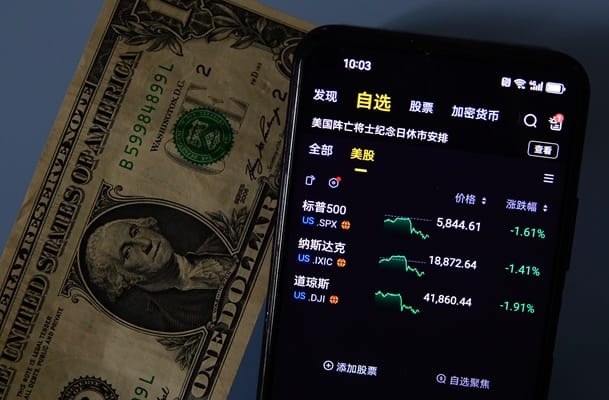The U.S. Dollar Index (DXY) is posting modest gains near the 98.40 level in Friday’s session, amid notable market caution ahead of the release of August Personal Consumption Expenditures (PCE) inflation data, one of the most critical indicators guiding the Federal Reserve’s monetary policy decisions.
This climb, which pushed the index to its highest level in nearly three weeks, cannot be viewed merely as a technical move, but rather as a reflection of several economic factors that have temporarily bolstered confidence in the U.S. currency, while at the same time raising questions about the sustainability of these gains given the uncertainty surrounding the future path of interest rates and inflation.
Recent economic data confirm that the U.S. economy still enjoys significant momentum.
The final estimate of Q2 GDP showed annualized growth of 3.8%, higher than the previous reading and above the market consensus of 3.3%. In my view, this performance reflects the resilience of economic activity at a time when much of the world is facing slowdowns in key sectors due to inflationary pressures and the lingering effects of tighter monetary policy in recent years.
At the same time, initial jobless claims fell to 218,000, below expectations, further reinforcing the strength of the labour market and supporting the Fed’s cautious stance before committing to deeper rate cuts.
Despite these positive indicators, monetary policy remains central to explaining DXY’s moves. The divergence in Fed officials’ remarks underscores the internal split on the appropriate timing to begin the next easing cycle. Jeffrey Schmid has argued for rate cuts to protect the labour market from potential future pressures, while Austan Goolsbee has stressed the risks of doing so while inflation remains above target. Mary Daly has taken a more cautious stance, noting that balancing employment objectives with price stability requires measured—not hasty—decisions. These mixed signals leave markets in a state of constant anticipation, with decisions increasingly tied to incoming inflation and labour data.
Markets are currently pricing in a potential 50 basis point rate cut over the Fed’s remaining two meetings this year, but this outlook remains fragile and subject to change based on surprises in inflation or labour market data. In this regard, the U.S. PCE index holds exceptional importance. Expectations point to headline PCE rising 2.7% year-on-year in August, with core PCE—excluding food and energy—rising 2.9%. If the data come in line with or below forecasts, the Fed could have justification for accelerating rate cuts, which would weigh directly on the dollar. Conversely, higher-than-expected readings would strengthen the case for maintaining tighter monetary policy for longer, potentially giving the dollar further upside.
In my view, current DXY gains near 98.50 may prove temporary if inflation data disappoints, particularly given markets’ hypersensitivity to any sign of easing price pressures. In that case, we could see a swift reversal in the dollar’s trajectory, especially against the euro and yen, where rival currencies would seize on dollar weakness to recoup recent losses. That said, the relative strength of the U.S. economy compared to other major economies—Europe struggling with industrial stagnation and Japan adhering to ultra-loose monetary policy—continues to provide a medium-term support base for the dollar, even if short-term momentum slows.
The most likely scenario, in my opinion, is for the dollar to remain in a limited range between 97.80 and 99.20 in the coming weeks, pending greater clarity on inflation trends and the Fed’s stance in upcoming meetings. A sustained break above 98.50 requires clear support from data, which could materialize if PCE prices continue resisting downward pressure. A drop below 98.00, however, would signal that markets are starting to price in imminent rate cuts based on weaker fundamentals.
In conclusion, the dollar index’s movements reflect a complex interplay between domestic economic strength, shifting interest rate expectations, inflationary pressures, and policymakers’ diverging positions. Today’s PCE release will serve as a cornerstone for reshaping investor outlooks in the weeks ahead. If the data confirm persistent price pressures, the dollar will likely maintain recent gains and potentially test higher levels. If inflation softens more than expected, however, the notion of a temporary peak at 98.50 will gain traction, with the greenback gradually losing strength.
Therefore, investors should exercise caution in building long-term dollar positions ahead of the data, maintaining flexibility to respond swiftly to surprises. Recent history has shown that the Fed does not hesitate to shift its tone when fundamentals change, making every major economic release—particularly PCE—a decisive factor in shaping the dollar’s direction in the near term.
Technical analysis of Dollar Index ( DXY ) prices
The technical outlook for the U.S. Dollar Index (DXY) indicates that the index successfully broke through previous resistance levels around 97.80 and continued its advance to nearly 98.50, which currently represents a psychological barrier and a key short-term resistance. The recent bullish move was strong and swift, forming a clear bottom near 96.60, reflecting renewed buying momentum supported by short-term positive sentiment. However, technical indicators are showing early signs of overbought conditions, which could limit the continuation of the upward momentum in the near term.





Leave a Comment